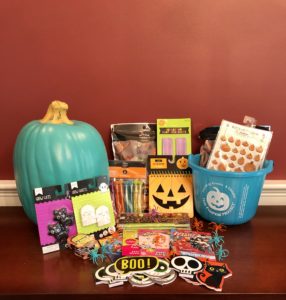 On an average day, having a child with food allergies can be really challenging for Moms and Dads. But allergies and Halloween? That can be downright, well, frightening.
On an average day, having a child with food allergies can be really challenging for Moms and Dads. But allergies and Halloween? That can be downright, well, frightening.
I say this from experience. My son was diagnosed with peanut, tree nut, and egg allergies before his first birthday. When that happened, our world changed. Suddenly food became my nemesis and greatest source of maternal stress. Not only can exposure to nuts or egg cause the discomfort of itchy hives for him, but at any time they can trigger anaphylaxis: a severe and potentially life-threatening allergic reaction.
Making sure my son doesn’t eat nuts and eggs is only the first line of protection. We also have to make sure he doesn’t come in contact with them via surfaces and the hands, faces, and clothes of the children (and adults) around him.
Needless to say, Halloween isn’t the fun, carefree evening of costumes and candy that I remember growing up!
Until our son turned five and was old enough to recognize safe and unsafe candy, we didn’t let him trick-or-treat independently. We loomed over him, ensuring that he didn’t stick his hand into a giant bowl full of poison (a.k.a. peanut butter cups). Rather than enjoying the night, sauntering a few steps behind the kids with our neighborhood friends, my husband and I were on high alert, taking turns “helicoptering” to keep him safe.
We also had to keep an eye on the children around him. I remember freaking out when his adorable little friend dipped into her bag of candy, hoping she’d pick something safe. She didn’t. Then I prayed she wouldn’t touch him after eating her nut-laden candy bar. Allergies and Halloween? Yep, it’s a tough combo.
Of course, my son didn’t have to participate in trick-or-treating. I realize it’s optional. But my husband and I want him to experience a normal childhood, and also to learn that he can do anything his friends can do—just with some tweaks to keep him safe. He won’t be able to live in a bubble— as much as I keep trying to design one as my side hustle!
But he’s not alone. According to FARE (Food Allergy Research & Education), 5.6 million children in America under the age of 18 have food allergies. That’s 1 in 13!
If you don’t have a child with a food allergy, you probably don’t think twice about things like what candy you buy for trick-or-treaters. Why would you? Plus, I’d imagine it feels overwhelming to try and accommodate for all the crazy dietary things that seem to be emerging these days. If you eliminate peanuts, tree nuts, milk, soy, gluten, egg, and more—what are you left with? Handing out water on Halloween?
It might feel easier to leave it up to those of us who are forced to deal with it. But I’d love for you to consider four ways that you can help, by preparing for trick-or-treaters in a way that will make the night fun and safe for all the children in your neighborhood.
1. Consider Buying Allergy-Safe Halloween Candy
Did you know common candy like Dots, Skittles, Ring Pops, Smarties, Sour Patch Kids, Starburst, Swedish Fish, Dum Dums, and Jelly Belly jelly beans are (to the best of my knowledge and research) free from the top 8 allergens? Easily available in most Halloween candy aisles, these are great options to offer on Halloween.
2. Use Separate Bowls for Treats
If you’re offering multiple candy options, consider putting each option in a separate bowl rather than mixed together in a big one. By separating them, it’s easier for children (and their incredibly loving yet highly anxious parents) to see the choices and select something safe without coming in close contact with something that’s not.
3. Participate in the Teal Pumpkin Project®
Teal pumpkins are now used to signal that non-food treats are available for children with allergies. (And keep in mind, there are also lots of other reasons why trick-or-treaters might benefit from something besides candy: lactose-intolerance, Celiac disease, diabetes, metabolism issues, and food dye sensitivities to name just a few.)
 Here’s how to participate:
Here’s how to participate:
Either paint a pumpkin teal and put it out or print out and display one of these signs on your front door to show you have non-food treats available. This movement is really gaining steam, so you can also easily find teal pumpkins items at Walmart, Target, and Michaels.
Then, stock up on some little treats. You can find relatively inexpensive things in the dollar section at Target or even by buying in bulk from online retailers like Oriental Trading. Crowd-pleasers are things like mini Play-Doh containers, stickers, glow sticks, bouncy balls, and spider rings. (Last year, I went to Michaels on October 30, and all the Halloween trinkets were on sale! Sometimes it literally pays to be a hot mess!)
4. Ask: “Does anyone have any food allergies?”
Life is expensive. And surprisingly, so are those enormous bags of Halloween candy. It might not be in your budget to buy a basket full of additional non-candy treats. But maybe you could grab just a few things to keep right by the front door. When you open the door for trick-or-treaters, simply ask, “Does anyone have any food allergies?” When you get a “yes,” you can give out your non-food treats until you run out. I guarantee it will make that child’s day—because he or she feels included, and also because he or she hears that when it comes to allergies and Halloween, neighbors are on it, too.
See? It’s easy to make trick-or-treating more inclusive and safe for all your trick-or-treaters. Happy Halloween to all!











